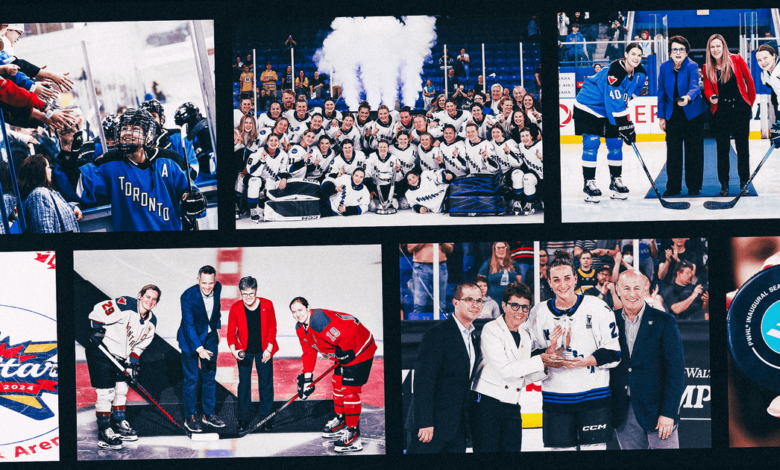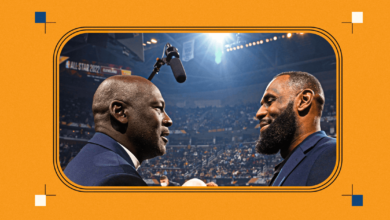The PWHL pulled off its inaugural season. Year 2 will decide the future of women’s pro hockey

Marie-Philip Poulin stood on the blue line at the Bell Centre, fighting back tears.
She had just been introduced to a world record crowd in Montreal and the fans were giving her a deafening ovation. Poulin, the best women’s hockey player in the world for almost a decade, typically gets the loudest pregame cheer, especially in her home province of Quebec. But this applause — over 20 seconds long and delivered by 21,105 people — was different.
“Honestly, I didn’t know what to do, how to react, the emotions were so high,” Poulin said. “Having the Bell Centre packed for women’s hockey … it (felt like) we finally made it.”
That April 20 game broke the all-time attendance record for women’s hockey, one of many milestones for the inaugural Professional Women’s Hockey League season. Since its launch in January 2024, the long-awaited six-team league featuring the world’s best players has largely been heralded as a success. Millions of viewers tuned in for games; attendance records were repeatedly set and broken; and demand for tickets in some markets was so high that teams have already moved into bigger venues. Just last month, the league announced that it was preparing for expansion as soon as the 2025-26 season — sooner than anticipated.
But there were bumps along the way, and with the arrival of the PWHL’s second season, which begins on Saturday, big-picture questions loom. Now that the league is no longer sparkling brand new, can it maintain positive momentum? And what needs to happen to set the PWHL up for long-term success?
Five days into the PWHL’s inaugural season, Stan Kasten had seen enough.
Kasten was on a tour around the league, making stops at most teams’ home openers during the first week of the season. He visited Toronto for the first PWHL game on Jan. 1, attended a sell-out in Ottawa the next day, and watched games in New York and Boston.
Then Kasten got to Minnesota for the team’s home opener, which set a women’s pro hockey attendance record with over 13,000 fans at the Xcel Energy Center.
“That was the day I knew this was going to work,” Kasten said.
The longtime sports executive and president of the Los Angeles Dodgers became a central figure in women’s hockey after Dodgers majority owner Mark Walter and his wife, Kimbra, agreed to bankroll a new professional women’s hockey league.
The PWHL came together in a six-month sprint. Six markets and venues were chosen. A 72-game schedule was assembled. General managers and coaches and league staff were hired; players were signed and drafted. With so little time, teams played without traditional names, logos or jerseys.
“I will look back in amazement that we did it,” Kasten said. “We set the six months as our goal. … I was too dumb to know it wasn’t possible.”
The inaugural game on Jan. 1, between Toronto and New York, was sold out, albeit at Toronto’s 2,600-seat venue. Tennis legend Billie Jean King — who sits on the league’s advisory board — dropped the ceremonial puck alongside PWHL senior vice president of hockey operations Jayna Hefford. The game reached over 3 million views on Canadian television networks and the league’s YouTube stream.
“It was that moment where you’re like, ‘my childhood dream is coming true,’” said Toronto defender Jocelyne Larocque. “I had tears in my eyes because as a kid, my dream was to play pro hockey. And then, as you get a bit older, you think because I’m a woman, this isn’t going to happen for me.”
The next day, the league broke an attendance record for a women’s professional hockey game in Ottawa with over 8,000 fans at TD Place Arena. That was the record Minnesota smashed only four days later.

Fans packed the Tsongas Center in Lowell, Mass., for a Minnesota-Boston PWHL game during the first week of the league’s inaugural season. (Maddie Meyer / Getty Images)
The honeymoon phase didn’t end after the first few weeks of the season either. The league set a world record for attendance in Toronto (19,285) in February at Scotiabank Arena, which was broken two months later at the Bell Centre when Poulin received the ovation.
Overall, the league beat its own modest attendance projections for the inaugural year. According to Kasten, the internal projection was around 1,000 fans per game. The actual figure — over 5,000 — is a major accomplishment considering that previous women’s hockey leagues mostly struggled at the gate.
“Going into this season, no one really knew what to expect. We knew that we had a product that was worth watching and that we were going to do the best we could to showcase women’s hockey,” said Toronto goalie Kristen Campbell. “The fan support (exceeded) my expectations.”
Games throughout the season were uptempo, highly skilled and surprisingly physical. They were also easy to watch, since every game was available on YouTube for free — with high-quality broadcast production paid for by the league.
“I just don’t think a lot of people understood the skill level and the athleticism of these players,” said Ottawa GM Mike Hirshfeld. “And I think once they saw that, it became really attractive.”
The league landed several partnerships with major brands — such as Air Canada, Scotiabank, Bauer and Barbie — and worked with the NHL, going to All-Star Weekend and playing two neutral-site games at NHL venues in Pittsburgh and Detroit.
But the inaugural season was far from perfect.
PWHL merchandise flew off the shelves despite a lack of team names or logos, but the rollout was criticized because of supply issues and the limited size ranges.
The New York franchise played in three different rinks and struggled to draw fans, finishing with the worst attendance in the league. One game in Bridgeport, Conn., had only 728 fans — the league’s only game with fewer than 1,000 all season.
And just nine days after Minnesota won the first-ever Walter Cup, the league announced it was parting ways with the team’s general manager, Natalie Darwitz, “effective immediately.”
Some reports suggested there was a rift between Darwitz — a legend of Minnesota hockey and now a Hockey Hall of Fame inductee — and head coach Ken Klee, with some influential players siding with Klee. However, the league maintained the decision came after a review of the team’s operations that found “there wasn’t a path forward with the current personnel in place.”
Still, when the PWHL hosted the 2024 draft and awards in St. Paul, Minn., four days after Darwitz departed, fans were dispirited. Klee, who was responsible for the team’s draft picks, was booed at points during the night. He was also heavily criticized for selecting Britta Curl, who stirred controversy in the weeks leading up to the draft for her social media activity.
When asked about Darwitz’s departure this month, Minnesota captain Kendall Coyne Schofield said it was a league decision. Klee, meanwhile, said the team was focused on moving on.
“It’s pro hockey. Things happen,” he said. “We’re excited to get the season going.”

Kendall Coyne Schofield raised the Walter Cup after Minnesota won the PWHL’s inaugural league championship. (Troy Parla / Getty Images)
If the PWHL’s first season was about celebrating the league’s existence, its sophomore year, just days away, will focus on maintaining momentum while remaining in startup mode.
“We are far from a finished product,” said Kasten.
The league has taken several positive steps in its first real offseason.
In September, it unveiled team names and logos; jerseys were released earlier this month. The coinciding merchandise offerings have included more design options and size ranges.
New York has moved into a single primary venue — the Prudential Center in Newark, N.J., where the team played in front of its biggest crowd (5,132) last season — while Toronto and Montreal have moved into bigger venues full-time.
“We always hoped and planned to be in bigger buildings, but I don’t think we expected it so quickly,” said Hefford. “But that demand was real and it wasn’t just a blip. It wasn’t just inaugural-year excitement. And we’re seeing that in the response from fans this year in terms of ticket sales and memberships.”
Even with an 8,150 capacity at Coca-Cola Coliseum, Toronto’s season-ticket memberships sold out for a second year in a row. And Kasten said the league expects average attendance to increase.
The PWHL will also play nine neutral-site games, mostly in NHL buildings including Seattle, Vancouver, Denver and St. Louis.
“It’s a reinforcement of what we perceive as widespread and growing interest around our sport,” he said of the neutral-site games. “I can’t say it enough times, these women, these world-class athletes who have been overlooked for so long, are finally seeing the recognition they should have been receiving for years and years.”
Perhaps the biggest development of the offseason is that the league is already looking to add up to two teams as soon as 2025-26. Last season, league leadership often tried to head off questions about expansion but Kasten said the success of Year 1 convinced league leaders to start the process sooner.
“I don’t know if we do it,” he said. “But we’re looking at it because the interest is really there.”
The league has sent out over 20 requests for proposals to interested potential expansion partners, said Amy Scheer, the PWHL’s senior vice president of business operations.
A major driver of PWHL expansion is the influx of international players. In June, over a dozen international players — from Finland, Sweden, Russia, Czechia and more — were drafted, alongside dozens more players from the NCAA. That so many players have decided to make the jump to North America is an encouraging sign. Most top players elected to stay in Europe last season and track the new league’s progress from afar.
“It became more clear what the league is going to look like and so now, I feel like everybody is trying to get a spot here,” said Team Germany forward Laura Kluge, who was invited to Toronto’s training camp after going undrafted in June. “The goal is to come here and play because (it’s) the most professional league out there.”
One of the major critiques of the PWHL last season was that — with the seven-team Premier Hockey Federation shutting down in June 2023 — the ecosystem for women’s hockey in North America became too small, with very few roster spots and development opportunities. Expansion would fix that without diluting the product, given how much talent should be coming from Europe and the NCAA over the next two years.
How expansion might work still remains to be seen. All six current PWHL teams, as well as the league itself, are owned by the Walters.
The single-entity ownership model was critical, Kasten said, to the league getting up and running as quickly as it did. But the question remains: Will the business eventually outgrow unilateral control?
Women’s hockey has attempted individual ownership in the past. The original National Women’s Hockey League folded, in part, because owners stopped seeing the value in investing. The PHF sold some teams, but the league’s main financial backers — John and Johanna Boynton — still owned four of the league’s seven teams.
“I love how it has worked for us so far. I don’t know when that model stops being the most efficient, if ever,” Kasten said. “Could that change in the future? I suppose it could, but we don’t have any plans to change it now.”
For all the progress made during this offseason, there are some longer-term benchmarks left.
The PWHL does not have the kind of media rights deals that are traditional in men’s pro sports, and those more recently signed in women’s professional basketball and soccer.
“Let’s face it, until we get a mature media plan and media revenue we won’t really be a full-fledged league,” said Kasten.
Last season, every game was broadcast on the league’s YouTube channel. This season, however, Canadian audiences won’t have access to the PWHL’s YouTube stream. Those streaming rights are now exclusive to the league’s Canadian broadcast partners, which include TSN, CBC and Amazon Prime. U.S. broadcast rights have not been announced. Pulling games off YouTube in Canadian markets is a hit to access and visibility, but the league is expected to make more money from an increase in rights fees.
“The change is positive for the league because it helps us grow in terms of stability,” Scheer said. “It helps us grow to ensure that the league is on the path to long term health and that women’s hockey will be here for good.”
The biggest challenge for the league is going to be the wage gap that exists between top players and those who make up the majority of each team’s roster, due to how the collective-bargaining agreement set player compensation and roster construction.
In Year 1, the top six players on each team were required to make at least $80,000 on guaranteed three-year contracts, per the CBA. Meanwhile, the league minimum was set at $35,000, which will increase by 3 percent to $36,050 in 2024-25. Many players’ salaries are closer to league minimum on non-guaranteed contracts. And given how much of the salary cap has already been allotted to top players, incoming players — or free agents deserving of raises — will be feeling the squeeze until those contracts expire after the 2025-26 season.
It’s a trickier problem to fix with the CBA locked in until July 31, 2031. But it’s something the league will inevitably be judged on if the business continues to grow.
Despite all these questions, perhaps the biggest change in Year 2 will be a focus not so much on milestones and records but more on the game itself.
“There were a lot of firsts last year and a lot of emotional moments — moments that were bigger than hockey,” said Poulin. “This year is about making it normal that we play in bigger buildings that sell out, that people are excited (to be there). And now we’re just going to play hockey because that’s our job.”
(Illustration: Meech Robinson / The Athletic. Photos: Mark Blinch, Minas Panagiotakis, Bruce Bennett / Getty Images; Kevin Sousa / NHLI via Getty Images; M. Anthony Nesmith / Icon Sportswire via Getty Images)




